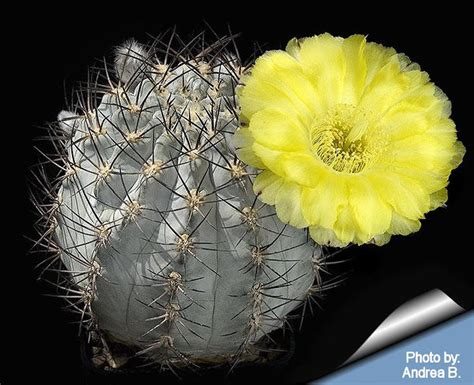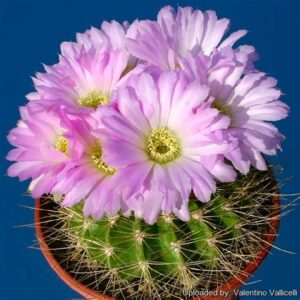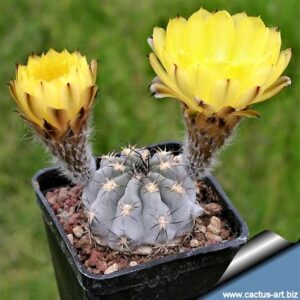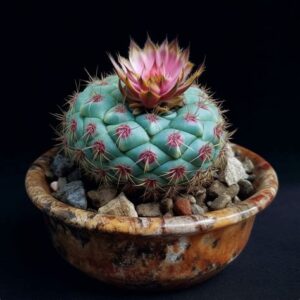Acanthocalycium thionanthum var. glaucum is a fascinating specimen within the expansive world of cacti. This species stands out not merely for its aesthetic appeal but also for its intriguing adaptations and behavior, which captivate both novice enthusiasts and seasoned collectors alike. In this article, we shall delve into the myriad facets that make this cactus variety a subject of fascination, exploring its physical characteristics, cultivation requirements, and the ecological significance that enhances its allure.
The Tantalizing Anatomy of Acanthocalycium Thionanthum var. Glaucum
The Acanthocalycium thionanthum var. glaucum is characterized by its distinctive morphology. Typically, this cactus features a globose to cylindrical shape, which can grow up to 15 centimeters in height. Its skin, or epidermis, showcases a stunning glaucous hue, which is a powdery, waxy coating that can appear bluish or silvery, rendering it a standout in any collection.
Another striking feature is its areoles—small, cushion-like structures from which spines and flowers emerge. These spines can vary in coloration from a vibrant yellow to a deep reddish-brown, often creating a poetic contrast against its powdery surface. The flowers, which bloom in late spring to early summer, are another hallmark of this species; they can measure up to 5 centimeters in diameter, typically showcasing hues of pink, red, or white. The flowers emerge from the apex of the cactus and offer a visual spectacle that attracts both pollinators and human admirers alike.
Ultimately, the beauty of Acanthocalycium thionanthum var. glaucum lies in its intricate structure, inviting a closer examination of its adaptations and the evolutionary pressures that shaped it.
Cultivation: Nurturing the Glaucum in Your Own Collection
Growing Acanthocalycium thionanthum var. glaucum is an endeavor that combines horticultural skill with a natural appreciation for plant care. This cactus is relatively forgiving, making it accessible for those beginning their journey into cactus cultivation, yet it retains enough unique preferences to engage more experienced growers.
Soil and Drainage: Creating the Perfect Base
This species thrives in well-draining soil. A cactus mix, possibly enriched with perlite or sand, ensures that moisture does not linger, which can lead to rot—a common pitfall in cactus cultivation. The ideal pH for the soil should be slightly acidic to neutral, ranging from 6.0 to 7.0. This balance allows for optimal nutrient uptake while mitigating issues associated with poor drainage.
Lighting Requirements: Zoning In on Sunlight
Acanthocalycium thionanthum var. glaucum flourishes under bright, indirect sunlight. While it may tolerate direct sunlight, excessive exposure can result in sunburn—an unsightly condition manifested as bleached patches or scorched skin. Therefore, positioning this cactus in a location that receives ample filtered light will promote healthy growth and vibrant flowering.
Watering Practices: A Balancing Act
Watering is another critical aspect of cultivation. During the growing season—spring and summer—moderate watering is vital. Allow the soil to dry out completely between watering sessions. Conversely, during the dormant season in the fall and winter, reduce watering significantly, as the risk of overwatering increases substantially during this period. The careful modulation of water, particularly the embrace of drought periods, mimics the habitat preferences of cacti in their native environments.
Fertilization: Nurturing Growth
When it comes to fertilization, a diluted cactus fertilizer can be used during the growing season to provide essential nutrients, including potassium and phosphorus, which support robust flower development. Care should be taken to avoid over-fertilizing, as this can lead to spindly growth or a decline in the plant’s overall health.
Common Pests and Diseases: Vigilance is Key
Like many plants, Acanthocalycium thionanthum var. glaucum is not without its vulnerabilities. Scale insects and mealybugs can pose threats, requiring timely intervention. Maintaining good air circulation and regularly inspecting your cactus significantly mitigates these risks, allowing for a thriving specimen.
The Ecological Role of Acanthocalycium Thionanthum var. Glaucum
Understanding Acanthocalycium thionanthum var. glaucum entails appreciating its ecological role in the arid ecosystems where it flourishes. Native to regions characterized by minimal rainfall and intense sunlight, this cactus has evolved several remarkable adaptations. Its glaucous exterior serves as a protective barrier against excessive transpiration, aiding in water conservation—a critical adaptation for surviving in dry climates.
Pollination and Seed Dispersal: Nature’s Symbiotic Dance
The flowering period of Acanthocalycium thionanthum var. glaucum is a momentous time for not just the plant but the surrounding ecosystem. Its vibrant blossoms attract various pollinators, including bees and hummingbirds. This interdependence highlights the species’ role in maintaining local biodiversity. Once pollinated, the flowers produce seeds that contribute to the genetic pool of the surrounding cactus population, enabling adaptability and resilience within its habitat.
Interactions with Other Flora and Fauna: A Web of Life
The habitat of Acanthocalycium thionanthum var. glaucum is often rich with a variety of other flora and fauna. Its presence may provide essential resources, such as shelter or nutrients, to other organisms. For instance, smaller insects may utilize the cactus as a microhabitat, while the fallen spines can enrich the surrounding soil, promoting further plant growth in their vicinity. This interconnected web of life showcases the importance of Acanthocalycium thionanthum var. glaucum beyond its mere visual appeal.
The Allure of Collecting: Why Cactus Enthusiasts are Drawn to Glaucum
Collectors and enthusiasts are often enamored by Acanthocalycium thionanthum var. glaucum due to its uniqueness and ease of care. The combination of its hardiness and striking beauty means that this species is an excellent choice for individuals looking to diversify their collections.
However, the allure runs deeper than just aesthetics. Each plant tells a story of survival in extreme conditions, reflecting the resilience of nature. By cultivating such specimens, enthusiasts can foster a deeper respect for the complexities of desert life. Furthermore, participating in the cultivation of cacti supports conservation efforts by promoting awareness and appreciation for these remarkable plants.
Conclusion: A Plant of Unfathomable Depth
In summary, Acanthocalycium thionanthum var. glaucum epitomizes the captivating charm of cacti. Its distinctive physical traits, coupled with specific cultivation requirements, invite connoisseurs and casual collectors alike to appreciate its beauty and significance within its native ecosystem. From its captivating structure to its essential ecological roles, Acanthocalycium thionanthum var. glaucum reveals the stories behind nature’s design and the delicate balance of life in arid landscapes. Engaging with this species not only enriches our understanding of cacti but also reinforces the importance of preserving our planet’s diverse ecosystems.





Leave a Comment